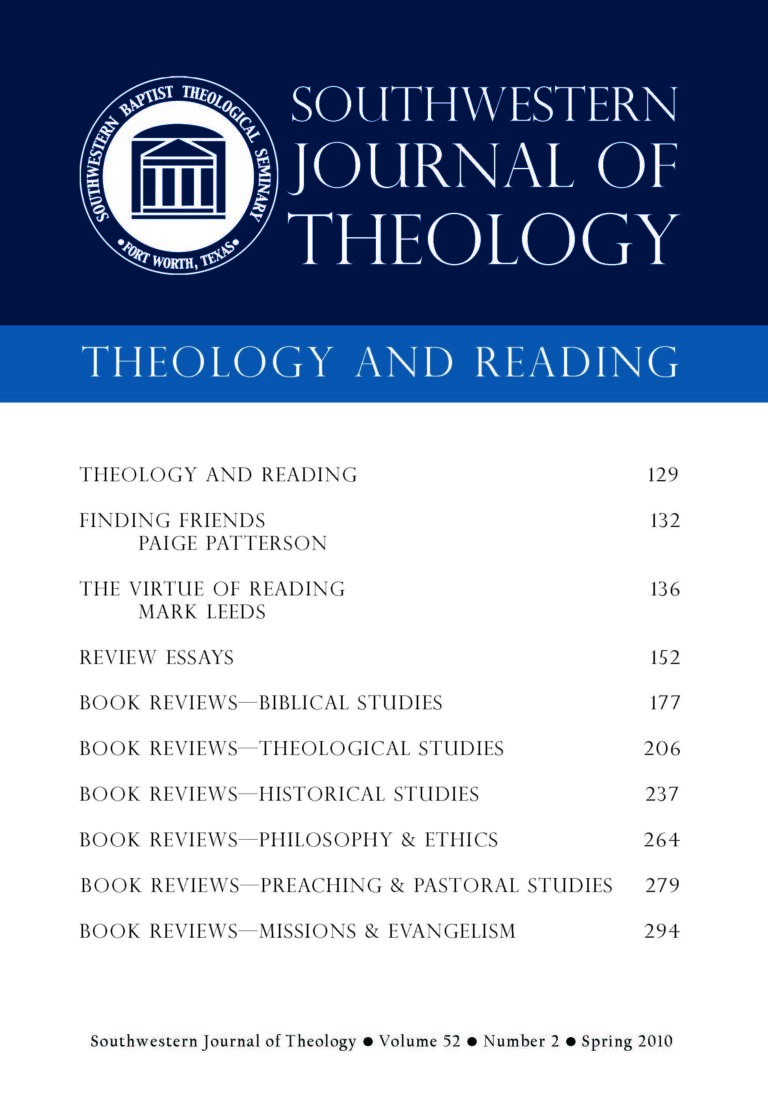
Theology and Reading
Southwestern Journal of Theology
Volume 52, No. 2 – Spring 2010
Managing Editor: Malcolm B. Yarnell III
Edited by A. Philip Brown II and Bryan W. Smith. Grand Rapids: Zondervan, 2008. 1652 + xxiii pages. Leather, $49.99.
A Reader’s Hebrew Bible is the Old Testament companion volume to A Reader’s Greek Bible. These volumes are not intended as critical scholarly editions of the Greek New Testament or the Hebrew Bible. As a result, A Reader’s Hebrew Bible is virtually a reproduction of Codex Leningradensis (in digital format, the Westminster Leningrad Codex 4.4), the manuscript that serves as the basis for the widely-used critical edition Biblia Hebraica Stuttgartensia. Since it is not a critical edition, there is no textual apparatus. The only textual variants noted are those preserved in the kethib and qere readings of Leningradensis. However, the lack of a textual apparatus does not detract from the purpose of the volume. The volume’s intended use is not exegesis or translation, but reading (xvii–xviii).
With the purpose of reading in mind, the key features of this volume are twofold: the presentation of glosses for less common Hebrew and Aramaic vocabulary and the screening of proper nouns for quick recognition. Although this number of features may seem limited, their accomplishment is no small task. Furthermore, their impact on facilitating a reader’s speed through the Hebrew Bible is drastic.
According to the editors they used a database to put together the glosses for the Bible (xxi). Although it is apparent that they checked each gloss (xx) in context, the procedure is still mechanical. In other words, reading A Reader’s Hebrew Bible does not simulate the experience of sitting down with a master teacher who provides helpful hints as the reader works through the text. Such a master teacher could quickly explain rare forms, unusual constructions, and uncommon spellings. Instead, the experience is still one of a reader sitting alone to work through the text; however, it has been made more convenient because there is no need to flip through the lexica to gloss any particular word. This observation serves as neither an endorsement nor a criticism. I offer it only to make the reader aware of the type of experience one should expect.
Given the vast number of glosses that are needed for the entire Hebrew Bible, the volume is quite accurate. There are a small number of noticeable mistakes that I expect will be corrected in future printings (incorrect numbering of words with glosses, some errors in screening proper nouns, etc.), but these mistakes are usually easily identified and will not create confusion for the vast majority of readers.
I would expect that a volume such as this one would be aimed at students who have a good grasp of the grammar of Biblical Hebrew. In many ways, A Reader’s Hebrew Bible is ideal for such students. It provides a way for them to apply their instruction without being overly burdened by their lack of vocabulary mastery. In this way, it helps facilitate their learning of the other aspects of Hebrew, especially syntax. On the other hand, the volume provides virtually no grammatical help, only the listing of the verbal stem for verbs that are glossed at the bottom. Rare grammatical forms and uncommon spelling abnormalities are not addressed at all. This lack of grammatical information will leave many intended readers confused and possibly frustrated. Those who have let their Hebrew sit dormant for some time will likely need to refresh their grammar before using this volume with success; however, this volume will help many who have had some training in Hebrew pick it back up or retain it.
The editors of A Reader’s Hebrew Bible have provided an accessible, helpful resource for regular reading of the Hebrew Bible. Furthermore, A Reader’s Hebrew Bible is nicely bound in Italian Duo-Tone, making it an attractive option for taking to public worship services. Although this volume will not replace critical editions of the Hebrew Bible nor constitute a primary source for exegetical study, it will facilitate better and faster reading. For this achievement, I for one am thankful.





